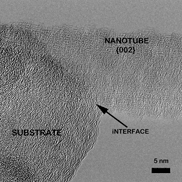Crossref Citations
This article has been cited by the following publications. This list is generated based on data provided by
Crossref.
Sharma, Munish
and
Chung, D. D. L.
2015.
Solder–Graphite Network Composite Sheets as High-Performance Thermal Interface Materials.
Journal of Electronic Materials,
Vol. 44,
Issue. 3,
p.
929.
Peng, Yitian
and
Deng, Kun
2015.
Fabrication of reduced graphene oxide nanosheets reinforced Sn–Bi nanocomposites by electro-chemical deposition.
Composites Part A: Applied Science and Manufacturing,
Vol. 73,
Issue. ,
p.
55.
Lee, Junyoung
Park, Taehee
Lee, Jongtaek
Yang, Jonghee
and
Yi, Whikun
2015.
Some Features of CdS/CdSe Quantum Dot‐sensitized Solar Cell Incorporating Carbon Nanotubes#.
Bulletin of the Korean Chemical Society,
Vol. 36,
Issue. 3,
p.
1019.
Renteria, J.
Legedza, S.
Salgado, R.
Balandin, M.P.
Ramirez, S.
Saadah, M.
Kargar, F.
and
Balandin, A.A.
2015.
Magnetically-functionalized self-aligning graphene fillers for high-efficiency thermal management applications.
Materials & Design,
Vol. 88,
Issue. ,
p.
214.
Amirhoseiny, Maryam
Zandi, Majid
Mosayyebi, Abolghasem
and
Khademian, Mehrzad
2016.
Carbon nanotube-based supercapacitors using low cost collectors.
Modern Physics Letters B,
Vol. 30,
Issue. 02,
p.
1550272.
Malekpour, Hoda
and
Balandin, Alexander A.
2018.
Nanopackaging.
p.
823.
Quinton, Betty T.
Elston, Levi
Scofield, James D.
and
Mukhopadhyay, Sharmila M.
2018.
Aligned Carbon Nanotube Arrays Bonded to Solid Graphite Substrates: Thermal Analysis for Future Device Cooling Applications.
C,
Vol. 4,
Issue. 2,
p.
28.
Razeeb, Kafil M.
Dalton, Eric
Cross, Graham Lawerence William
and
Robinson, Anthony James
2018.
Present and future thermal interface materials for electronic devices.
International Materials Reviews,
Vol. 63,
Issue. 1,
p.
1.
Zhang, Qiuhong
A. Calderon, Brian
R. Ebbing, Charles
J. Elston, Levi
W. Byrd, Larry
and
Tsao, Bang-Hung
2020.
Thermal Properties Enhancement of Vertically Aligned Carbon Nanotubes-Based Metal Nanocomposites as Thermal Interface Materials.
Frontiers in Materials,
Vol. 7,
Issue. ,
Khan, Junaid
Momin, Syed Abdul
and
Mariatti, M.
2020.
A review on advanced carbon-based thermal interface materials for electronic devices.
Carbon,
Vol. 168,
Issue. ,
p.
65.
Huang, Junchen
Miu, Guodong
Liu, Tongle
Huang, Chen
Guo, Shibo
and
Liu, Qian
2021.
Preparation and thermophysical properties of graphite flake-carbon fiber coreinforced copper matrix composites.
Materials Research Express,
Vol. 8,
Issue. 12,
p.
125603.
Bhardwaj, Aashish
Phani, A. Srikantha
Nojeh, Alireza
and
Mukherji, Debashish
2021.
Thermal Transport in Molecular Forests.
ACS Nano,
Vol. 15,
Issue. 1,
p.
1826.
Guo, Xiaoxiao
Cheng, Shujian
Cai, Weiwei
Zhang, Yufeng
and
Zhang, Xue-ao
2021.
A review of carbon-based thermal interface materials: Mechanism, thermal measurements and thermal properties.
Materials & Design,
Vol. 209,
Issue. ,
p.
109936.
Fu, Huaqiang
Xiao, Yong
Li, Peng
Qian, Wei
Li, Dan
Zhao, Xin
and
He, Daping
2022.
Ultrasonic-assisted soldering for graphite films as heat sinks with durably superior heat dissipating efficiency.
Advanced Composites and Hybrid Materials,
Vol. 5,
Issue. 3,
p.
2154.
Cao, Jing
Meng, Tzee Luai
Zhang, Xikui
Gong, Na
Karyappa, Rahul
Tan, Chee Kiang Ivan
Suwardi, Ady
Zhu, Qiang
and
Liu, Hongfei
2023.
Recent Advances in Thermal Interface Materials.
World Scientific Annual Review of Functional Materials,
Vol. 01,
Issue. ,
Zeng, Xiaoliang
Ren, Linlin
and
Sun, Rong
2024.
Thermal Management Materials for Electronic Packaging.
p.
211.
Li, Chenghang
Luo, Zhumei
Qing, Shan
Wang, Yixiang
Huang, Haoming
and
Zhang, Xiaohui
2024.
Investigation of nanocomposite PNIPAm‐g‐graphene with pre‐lower critical solution temperature rapid thermal response function for chip adaptive cooling: A molecular dynamics and computational fluid dynamics simulations.
Journal of Polymer Science,
Vol. 62,
Issue. 9,
p.
1934.



